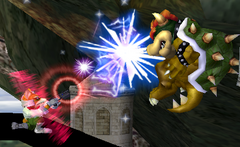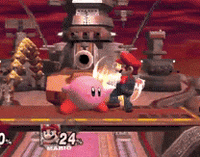Throw: Difference between revisions
No edit summary |
(edited smash 4 throw info) |
||
| Line 7: | Line 7: | ||
Throws cannot be escaped once started, with the exception of [[Donkey Kong]]'s [[forward throw|cargo throw]] and {{SSBM|Kirby}}'s forward and back throws in ''Melee''. In all four games, all throws grant eight [[invincibility]] frames to the thrower when started. However in ''Brawl'', the hitbox from the attacker (during [[Freeze frame|hitlag]]) does not get cancelled out by the thrower, meaning that the thrower can get hit by the same attack from the attacker once they exceed the eight-frame invincibility period. A general rule of throws is that characters that rely on supernatural powers ([[Lucario]], [[Ness]], [[Mewtwo]], [[Zelda]], and [[Lucas]]) have better throwing abilities than characters that don't; however, this often refers merely to the damage or [[knockback]] inflicted by the throws, as weak throws tend to be useful for starting combos, and can sometimes even lead into other KO moves. | Throws cannot be escaped once started, with the exception of [[Donkey Kong]]'s [[forward throw|cargo throw]] and {{SSBM|Kirby}}'s forward and back throws in ''Melee''. In all four games, all throws grant eight [[invincibility]] frames to the thrower when started. However in ''Brawl'', the hitbox from the attacker (during [[Freeze frame|hitlag]]) does not get cancelled out by the thrower, meaning that the thrower can get hit by the same attack from the attacker once they exceed the eight-frame invincibility period. A general rule of throws is that characters that rely on supernatural powers ([[Lucario]], [[Ness]], [[Mewtwo]], [[Zelda]], and [[Lucas]]) have better throwing abilities than characters that don't; however, this often refers merely to the damage or [[knockback]] inflicted by the throws, as weak throws tend to be useful for starting combos, and can sometimes even lead into other KO moves. | ||
Beginning in ''Melee'', some throws have their speeds affected by the grabbed character's [[weight]]; these are usually known as '''weight dependent throws'''. An easy example is comparing Mario's back throw speed against both [[Bowser]] and [[Jigglypuff]]; the latter is thrown about twice as fast. This effect is achieved by applying a [[frame]] multiplier to the throw equal to the target's weight divided by 100: in accordance to this formula, characters with weight values of 75 and 125 will cause a weight dependent throw to execute 25% faster and slower respectively (0.75x and 1.25x of the base duration), while a character with a weight of 100 will be thrown at the default speed. | Beginning in ''Melee'', some throws have their speeds affected by the grabbed character's [[weight]]; these are usually known as '''weight dependent throws'''. An easy example is comparing Mario's back throw speed against both [[Bowser]] and [[Jigglypuff]]; the latter is thrown about twice as fast. This effect is achieved by applying a [[frame]] multiplier to the throw equal to the target's weight divided by 100: in accordance to this formula, characters with weight values of 75 and 125 will cause a weight dependent throw to execute 25% faster and slower respectively (0.75x and 1.25x of the base duration), while a character with a weight of 100 will be thrown at the default speed. In ''Smash 4'', this formula uses the throw's full animation length, not the IASA. | ||
==Appearances== | ==Appearances== | ||
| Line 26: | Line 26: | ||
SSB throw.png|{{SSB|Ness}}'s forward throw in ''Super Smash Bros.''. | SSB throw.png|{{SSB|Ness}}'s forward throw in ''Super Smash Bros.''. | ||
Weight Comparison 2 Brawl.gif|Mario back-throwing Jigglypuff in ''Brawl''. | Weight Comparison 2 Brawl.gif|Mario back-throwing Jigglypuff in ''Brawl''. | ||
Weight Comparison 1 Brawl.gif|Said back throw takes | Weight Comparison 1 Brawl.gif|Said back throw takes significantly longer to complete with Bowser, a far heavier character. | ||
</gallery> | </gallery> | ||
Revision as of 18:18, July 20, 2017


A throw (投げ) is an attack performed after a character grabs an opponents, that ends the grab. Throws appear in all installments of the Super Smash Bros. series. In Super Smash Bros., two types of throws can be performed by pressing left or right on the Control Stick when grabbing the opponent. Beginning in Super Smash Bros. Melee, the player can also press up or down on the control stick, triggering two other throws. The main purpose of throws in general is to either start combos or create space between the user and their opponent.
Throws cannot be escaped once started, with the exception of Donkey Kong's cargo throw and Kirby's forward and back throws in Melee. In all four games, all throws grant eight invincibility frames to the thrower when started. However in Brawl, the hitbox from the attacker (during hitlag) does not get cancelled out by the thrower, meaning that the thrower can get hit by the same attack from the attacker once they exceed the eight-frame invincibility period. A general rule of throws is that characters that rely on supernatural powers (Lucario, Ness, Mewtwo, Zelda, and Lucas) have better throwing abilities than characters that don't; however, this often refers merely to the damage or knockback inflicted by the throws, as weak throws tend to be useful for starting combos, and can sometimes even lead into other KO moves.
Beginning in Melee, some throws have their speeds affected by the grabbed character's weight; these are usually known as weight dependent throws. An easy example is comparing Mario's back throw speed against both Bowser and Jigglypuff; the latter is thrown about twice as fast. This effect is achieved by applying a frame multiplier to the throw equal to the target's weight divided by 100: in accordance to this formula, characters with weight values of 75 and 125 will cause a weight dependent throw to execute 25% faster and slower respectively (0.75x and 1.25x of the base duration), while a character with a weight of 100 will be thrown at the default speed. In Smash 4, this formula uses the throw's full animation length, not the IASA.
Appearances
In Super Smash Bros.
Throws in Super Smash Bros. are usually attacks of high knockback. However, throws often have low knockback scaling, and as such are poor KO moves. Because of this, they are often followed up with edgeguarding techniques. The main exception to this is Captain Falcon and Jigglypuff, whose forward throws are both used for combos and have very little knockback scaling.
In Super Smash Bros. Melee
In Melee, throws in general inflict much less damage and knockback. Many throws, usually the newly-introduced up and down throws, have the capacity to combo into subsequent attacks, including grabs; repeatedly using throws that lead into another grab is known as chain grabbing.
In Super Smash Bros. Brawl
In Brawl, like in Melee, many throws can still be followed up with other attacks, and chaingrabs are still fairly frequent, as seen in Falco and King Dedede's down throw combos. However, due to the ability to act out of hitstun, guaranteed throw combos are now only possible at low percentages and with throws that inflict low enough knockback, making KO setups out of throws less common than in Melee. Additionally, some throws that used to KO in Melee such as Jigglypuff and Peach's forward throws have been nerfed in power.
In Super Smash Bros. 4
Throws have not changed much since Brawl other than an overall damage nerf. However, chaingrabbing has effectively been removed, as characters now have a 60 frame period in which they cannot be regrabbed. Also, throws have been rebalanced in terms of knockback. Characters who had weak throws (like Marth and Zero Suit Samus) had their throws' knockback heavily increased, although this also weakens their followups after a grab. On the other hand, the removal of hitstun canceling gives many new followup options out of a throw to characters like Luigi, Mr. Game & Watch, Sheik and Sonic.
Gallery
Ness's forward throw in Super Smash Bros..
Types
See also
| Attacks in the Super Smash Bros. series | |
|---|---|
| Standard ground attacks | Neutral attack · Dash attack |
| Tilt attacks | Forward tilt · Up tilt · Down tilt · Crouching attack |
| Smash attacks | Forward smash · Up smash · Down smash |
| Aerial attacks | Neutral aerial · Forward aerial · Back aerial · Up aerial · Down aerial · Grab aerial · Glide attack |
| Throws | Grab · Pummel · Forward throw · Back throw · Up throw · Down throw |
| Get-up attacks | Floor attack · Edge attack |
| Special moves | Neutral special move · Side special move · Up special move · Down special move · Command-input move · Final Smash |


